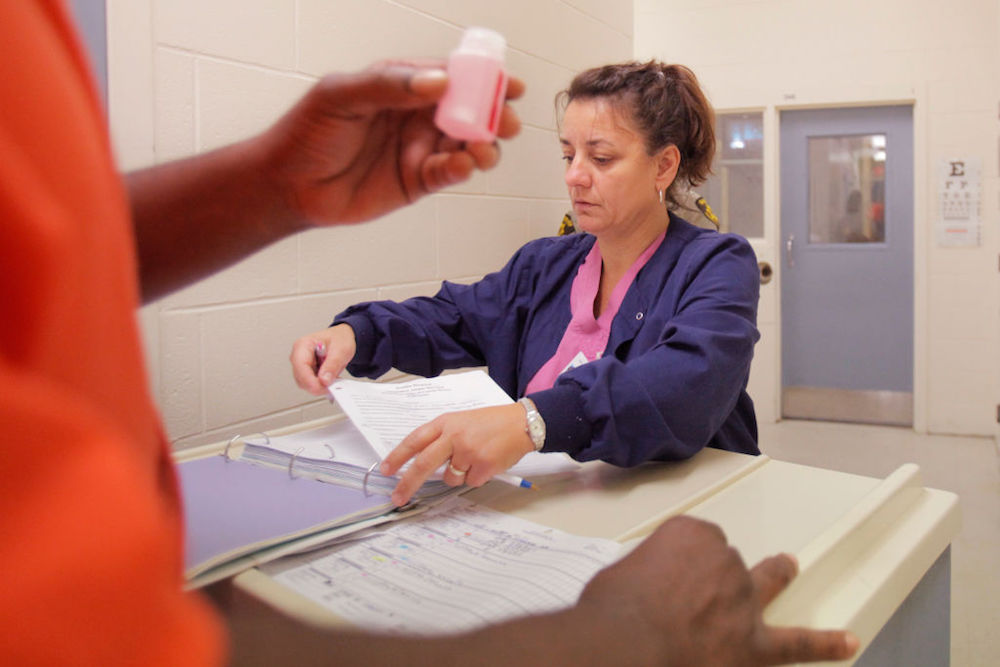By: Evelyn Rivas and Emily Osorio
Overdosing Statistics
So how much do we actually know about medication and substance abuse in prisons within the United States? According to the National Institute on Drug Abuse, approximately “85% of the prison population has a current active issue with substance use or have been incarcerated due to a crime involving drugs or drug use.” Death rates in jails and prisons throughout the United States have continued to elevate over the past decade by various means; however, many could consider that the main contributor to these numbers is the rate of overdoses. According to The Marshall Project, “From 2001 to 2018, the amount of prisoners that have overdosed from drug or alcohol intoxication have increased drastically to around 600%.

How have opiods affected New Orleans? (Photo: Krewe Magazine)
Throughout county jails, the increase of overdose deaths have escalated to 200%.” These numbers in comparison to the early 1900s have only escalated. In addition, according to the U.S Department of Justice, “The number of deaths in state prisons due to drug or alcohol intoxication increased from 25 in 2001 to 235 in 2019.” Emergency visits and hospitals majority of the time circulate around drug overdoses due to the uprising of overdoses in prisons, thus skyrocketing these numbers to around 50% occurring in the years of 2014 and 2017.
Consumption and Access to Drugs
Unfortunately, countless prisoners end up consuming drugs when they are isolated from others and deny help if there is an issue. Leo Beletsky, a law professor at the college Northeastern University, once stated, “People are bored and miserable and isolated, often self-medicating for mental and physical health needs that usually go unmet. Is it surprising that there’s such a demand for drugs in detention settings? Absolutely not.” Even if they were to find help, it would be limited and scarce anyways. The access to these drugs and illegal substances persist to rise, which creates this high percentage of overdoses.
There are many different kinds of ways drugs are entered in prisons: through packages and visitors, letters, and family members can even put drugs on a wet piece of paper and mail it to them. If these drugs pass the mail area, then the prisoners will then have access to swallow them, smoke them, or stash them in body cavities. In order to treat these issues, doctors provide methadone and buprenorphine to decrease the risk of overdoses by over 50% when contrasted to the reception without medication.
In a recent talk with Ivy Mathis, a re-entry specialist, she revealed how during her time in a Louisiana prison she witnessed how often prison psychiatrists coerce certain medications to non-ill patience in order to cure “anxieties” or “depression” any of these prisoners may feel. According to the Office of Justice Program, “Over 50 percent of all inmates diagnosed with depression disorders were treated with tricyclic antidepressants.” Oftentimes inmates come into the system with these prescribed medications other times nurses and psychiatrists prescribe them to inmates, declares John Hult in an article from the Argus Leader. However, it is important to note that while it seems to be simple to access these medications the scarcity for them is still prominent in certain state prison complexes.

BANGOR, ME – SEPTEMBER 15: Carmen Mulholland, a nurse with Allied Resources, dispenses methadone to an inmate at the Penobscot County Jail in Bangor (Staff Photo by Gregory Rec/Staff Photographer).
Overall, these medications to the public eye are deemed to be a lifesaver and safety vests for “mentally ill” people in prison, despite the fact that it is only elevating the issue of substance abuse. It is very peculiar how little engagement there is to the stigma challenging drug abuse within prisons. It is a heinous and peril matter that is not being incandescent in the way it should be which in hindsight, only fuels this quintessential idea around drug use. This issue in prison doesn’t end, it only becomes more clandestine Louisiana and the United States.
This piece is part of an on-going series from Professor Betsy Weiss’s class, “Punishment and Redemption in the Prison Industrial Complex,” which is offered through Tulane University’s School of Liberal Arts Young Public Scholars (YPS) Program, a pre-college summer program designed specifically for the emerging social justice advocate.
 NOLAbeings Multimedia artist Claire Bangser created NOLAbeings as a portrait-based story project that marries...
NOLAbeings Multimedia artist Claire Bangser created NOLAbeings as a portrait-based story project that marries...  Voodoo in New Orleans: Reviving history: New Orleans fortune telling This article takes a deep dive into the history of Voodoo in New Orleans, its hybridization with Catholicism, and its present-day place in the city's culture. The author visits fortune-tellers in the French Quarter, using their guidance as a tool for introspection rather than a deterministic predictor of the future. Through her experiences in New Orleans, the author feels a mystical connection to both the past and the future.
Voodoo in New Orleans: Reviving history: New Orleans fortune telling This article takes a deep dive into the history of Voodoo in New Orleans, its hybridization with Catholicism, and its present-day place in the city's culture. The author visits fortune-tellers in the French Quarter, using their guidance as a tool for introspection rather than a deterministic predictor of the future. Through her experiences in New Orleans, the author feels a mystical connection to both the past and the future. 